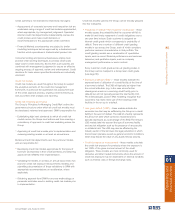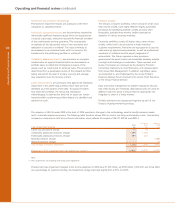RBS 2005 Annual Report Download - page 91
Download and view the complete annual report
Please find page 91 of the 2005 RBS annual report below. You can navigate through the pages in the report by either clicking on the pages listed below, or by using the keyword search tool below to find specific information within the annual report.
section
01
Operating and
financial review
89
Operating and financial review
Annual Report and Accounts 2005
Credit authority is not extended to relationship managers:
•Assessments of corporate borrower and transaction risk are
undertaken using a range of credit risk models supplemented,
where appropriate, by management judgement. Specialist
internal credit risk departments independently oversee the
credit process and make credit decisions or
recommendations to the appropriate credit committee.
•Financial Markets counterparties are subject to similar
modelling techniques but are approved by a dedicated credit
function which specialises in traded market product risk.
Consumer lending and personal businesses employ best
practice credit scoring techniques to process small scale,
large volume credit decisions. Scores from such systems are
combined with management judgement to ensure an effective
ongoing process of approval, review and enhancement. Credit
decisions for loans above specified thresholds are individually
assessed.
Credit risk models
Credit risk models are used throughout the Group to support
the analytical elements of the credit risk management
framework, in particular the quantitative risk assessment part
of the credit approval process, ongoing credit monitoring as
well as portfolio level analysis and reporting.
Credit risk modelling governance
The Group’s ‘Principles for Managing Credit Risk’ outline the
governance structure under which all credit risk models must
be developed, reviewed and approved. GRM is responsible for:
•Establishing high level standards to which all credit risk
models across the Group must adhere and thus ensuring a
consistency of approach to credit risk modelling across the
Group.
•Approving all credit risk models prior to implementation and
reviewing existing models on at least an annual basis.
Divisional credit risk departments own the particular models
and are responsible for:
•Developing credit risk models appropriate for the types of
borrower and facilities in their credit portfolios and obtaining
approval from GRM for their implementation.
•Validating the models on at least an annual basis (every two
years for credit risk exposure measurements models) and
submitting documentation of these validations to GRM with
appropriate recommendations on recalibration, where
applicable.
•Obtaining approval from GRM for any new methodology or
parameter estimates used in existing credit risk models prior
to implementation.
Credit risk models used by the Group can be broadly grouped
into four categories.
•Probability of default (“PD”)/customer credit grade – these
models assess the probability that the customer will fail to
make full and timely repayment of credit obligations over a
one year time horizon. Each customer is assigned an
internal credit grade which corresponds to probability of
default. There are a number of different credit grading
models in use across the Group, each of which considers
particular customer characteristics in that portfolio. The
credit grading models use a combination of quantitative
inputs, such as recent financial performance and customer
behaviour, and qualitative inputs, such as company
management performance or sector outlook.
Every customer credit grade across all grading scales in
the Group can be mapped to a Group level credit grade
(see page 90).
•Exposure at default (“EAD”) – these models estimate the
expected level of utilisation of a credit facility at the time of
a borrower’s default. The EAD will typically be higher than
the current utilisation (e.g. in the case where further
drawings are made on a revolving credit facility prior to
default) but will not typically exceed the total facility limit.
The methodologies used in EAD modelling recognise that
customers may make more use of their existing credit
facilities in the run up to a default.
•Loss given default (“LGD”) – these models estimate the
economic loss that may be suffered by the Group on a credit
facility in the event of default. The LGD of a facility represents
the amount of debt which cannot be recovered and is
typically expressed as a percentage of the EAD. The Group’s
LGD models take into account the type of borrower, facility
and any risk mitigation such as the presence of any security
or collateral held. The LGD may also be affected by the
industry sector of the borrower, the legal jurisdiction in which
the borrower operates as well as general economic conditions
which may impact the value of any assets held as security.
•Credit risk exposure measurement – these models calculate
the credit risk exposure for products where the exposure is
not 100% of the gross nominal amount of the credit
obligation. These models are most commonly used for
derivative and other traded instruments where the amount of
credit risk exposure may be dependent on external variables
such as interest rates or foreign exchange rates.
























